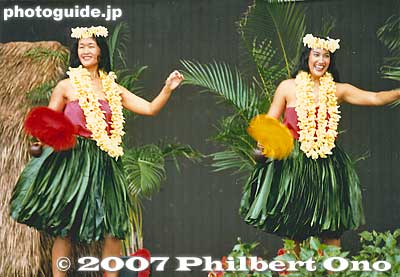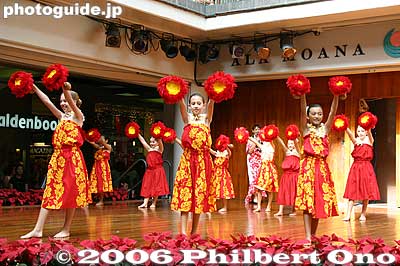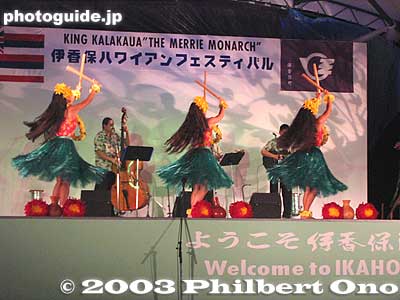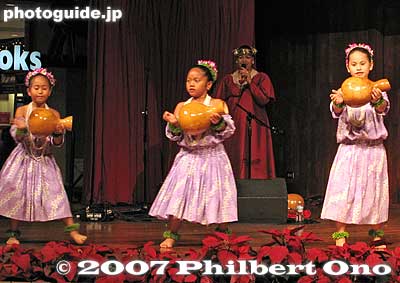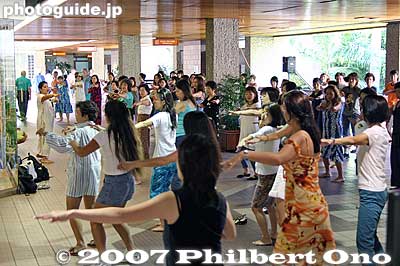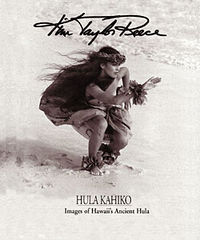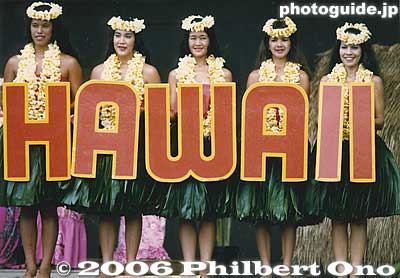Hula in Hawaii
Hula--Window to a Culture
| Symbol of Hawaii |
By Philbert Ono
This article was originally written for ANA's in-flight magazine in March 2004. It has been edited and expanded for this online version. Certain information here might be outdated.
Landing in Honolulu and seeing Diamond Head through the airplane window is when it hits home: I'm back in Hawaiʻi, my hometown. As I disembark along with a horde of Japanese on the same flight from Tokyo where I now live, I fantasize seeing hula dancers greeting us like the old days when tourists came by ship.
My imaginary hula dancers (at least three of them) are dancing with glee right in the arrival lobby. Sadly, the airport is too modern for that, I rationalize, as I gaze up at the massive concrete ceiling hanging over the shadowed, ground-level roadway outside. I catch a shuttle bus to escape the terminal and feel joy when the blue Hawaiʻi sky appears.
I came prepared for this "hula trip." I had read hula books, watched hula videos, and observed hula classes in Tokyo. All these years, even though I was born and raised in Hawaiʻi, I never thought of actually studying the hula even though I always loved to watch it.
Then in Aug. 2003, I was hired to be the interpreter for a well-known kumu hula (hula teacher) from Hawaiʻi who taught hula workshops at the annual Hawaiian Festival in Ikaho, Gunma, Japan. Meeting some of Hawaiʻi's best kumu hula and hula dancers really piqued my interest, and I found out that there was much more to hula than grass skirts and swaying hips. It was my belated hula awakening. Thereafter, hula would never again be "just a tourist thing" in my mind. I was glad to be learning more about the culture I grew up in.
Easy to be Hard
The thing about the hula is that it's both easy and hard. Easy because you can just watch and enjoy the hula like any tourist. The basic steps and hand motions are also easy to learn (or imitate).
It becomes hard when you delve below the superficial, entertainment level. The hula is not just a dance. It is entwined with many other elements like Hawaiian history and legends, the Hawaiian language, native religion, songs, chants, prayers, poetry, daily life, and the people, places, and events of Hawai`i. With all these strings attached to hula, understanding it becomes much more difficult, but all the more fascinating. Study the hula, and you learn a whole lot about Hawaiʻi besides just the dance.
For most of us, the greatest barrier to understanding the hula is the Hawaiian language, assuming that you're not fluent in it. Most hula songs and chants are in Hawaiian. So if you can't understand Hawaiian and there's no translation, you won't be able to hear or understand the story the dancer is telling (if it's not a prayer). It could be about the adventures of Hawaiʻi's ancient gods and goddesses (who have very human emotions), the natural climate and beauty of Hawaiʻi, Hawaiʻi's royalty, poetic expressions of love and even sex, and life in ancient and modern Hawaiʻi.
For serious hula students, learning the Hawaiian language is essential. The dancer must know the meaning of the mele (hula song or chant) verse-by-verse in order to convey it through the dance. And if the dance is about a specific place or event in Hawaiʻi, the dancer should have actually seen and experienced that place or event. As one hula teacher told me, "The dancer must understand the meaning of the song (if it's in Hawaiian), visualize the place or setting, and convey the emotions from the heart." If you did not grow up speaking Hawaiian, this can be quite difficult.
Hula Basics
| Uli uli feathered gourd rattles |
| Pu'ili bamboo rattles |
| Ipu gourd drums |
Knowing a few hula basics will make watching (or learning) hula more enjoyable and comprehensible.
First of all, there are two categories of hula: Hula kahiko and hula ʻauana. Kahiko is the ancient-style hula, and ʻauana is the modern-style hula. You can instantly tell the difference by looking at the type of musical instruments used. Hula kahiko is danced to a Hawaiian chant rather than a song, and only percussion instruments are used. Usually the ipu heke double-gourd drum or pahu tree-trunk drum is used. Hula kahiko dances are drawn from the period before Captain James Cook discovered Hawai`i in 1778. They can be a religious prayer or story-telling.
Hula ʻauana is danced to a song, and stringed instruments like the guitar, ukulele, and bass are heard. The song may be sung in English or Hawaiian. This modern-style dance was developed during the 1874-1891 reign of King David Kalakaua. It was this style that became popular with tourists ever since the early 20th century. Today, many hula shows perform both hula kahiko and 'auana.
Hula dancers can be both kane (men) and wahine (women) as well as keiki (children). And hula costumes are infinitely variable, not just green grass skirts.
The three most common hula implements used by hula dancers are the ʻuliʻuli gourd rattles with a feather top usually colored red and yellow, puʻili split bamboo rattles, and the ipu gourd drum. You might also see ʻiliʻili river stones used like castanets in each hand, and kalaʻau dance sticks.
Hula has several basic dance steps. The first step all hula dancers learn is the kaholo, a line of steps usually going to the left and right side. Other basic steps include kaʻo (sway), lele (walk), ami (round hip movement), and ʻuwehe (quick lifting of heels with knees expanding, creating a "poof" in the skirt).
After the dancer learns the footwork, he or she then learns the hand motions. There are hand motions for virtually everything in Hawaiʻi, from stars in the sky to fish swimming in the sea. Some of them, like ocean waves and falling rain, are obvious to recognize, but for most others you'd have to listen carefully to the lyrics to understand.
Since the ancient Hawaiians did not have a written language, the hula was used to pass on stories of Hawai`i's history and legends, royal genealogies, and prayers from generation to generation.
Hula Dancers
Wanting to see some hula shows, I logically started off in Waikiki. Having the largest concentration of hotels and tourists in the state, Waikiki is the nucleus of Hawai`i's tourist trade. And where there are tourists, there are hula shows (and hula dancers).
What could be Waikiki's second longest-running hula show is at the Halekulani Hotel's House Without a Key restaurant fronting the beach. The sunset hula show features a live band and Kanoelehua Kaumeheiwa Miller who has been dancing here since 1977. With such an amazingly long run, she has become a Waikiki institution. The show is held every evening except Sunday.
A former fashion model, Miss Hawaii 1973, and flight attendant, Kanoe is tall, elegant, and beautiful. It was almost sunset and about 20 minutes before show time when Kanoe breezed in to our table along with the familiar aroma of plumeria adorning her hair and neck.
I mentioned that I graduated from the same high school as her (some years after her), and that started a good rapport. At the Miss America Pageant, they did not allow her to do the hula for the talent portion of the contest. "It was the only thing I could do, and they said it was too much of an ethnic thing!"
Kanoe started taking hula lessons at age 13 from Aunti Maiki Aiu, a well-known hula teacher. But, "I got kicked out at age 16 because I was working as a fashion model at the same time and could not devote myself to hula as much as I supposed to. I was the only one who went to class with all this make-up on."
Aunti Maiki required a certain level of commitment from her students. This is a word we often hear in hula. It takes commitment to study hula. And it takes a lot more commitment to become a kumu hula or hula teacher.
Kanoe knows what that commitment is. After dancing for so long, you would think that she would be able to teach hula. "I receive many requests to teach hula, but I turn them down because I`m really not qualified. I haven't committed myself to reach the level of a kumu hula." "Kumu hula" is a time-honored and prestigious title bestowed by a mentor kumu hula. It can take years before one is qualified to go through the uniki graduation ritual.
"You know, I just like to dance!" exclaimed Kanoe.
| Bishop Museum hula show, |
Not all hula dancers are female (wahine). There are male (kane, pronounced KAH-nay) dancers as well. For example, Robert "Keano" Kaupu and Lono Padilla whom I met at Bishop Museum's hula show. The hula show was led by musician Roland Chang and included two women dancers.
Both Keano and Lono are top-notch hula dancers who have experience in both competitive hula (i.e., Merrie Monarch Festival) and professional hula. Both agreed that competitive and professional hula are very different, and both preferred the latter.
Lono once worked at the famous Kodak Hula Show (later renamed Pleasant Hawaiian Hula Show) which was unfortunately discontinued in 2002. Both started learning the hula during childhood and never thought that they would grow up to be professional hula dancers. "I got into this by chance. Someone just asked me to help out and dance with them," says Keano.
I asked what they considered to be the best hula dancing jobs. "The best jobs are the steady jobs where you can dance on a regular basis," asserts Keano. As to how professional hula dancers get hired for jobs, "We find jobs mainly through a friend or relative. It's a close-knit network so there are all these connections."
Lono adds, "You also need to have a good repertoire of learned dances because when you work with different people, you need to adapt to their program quickly."
Keano also gave an interesting anecdote about Waikiki show biz. "For the Waikiki shows, they first hire dancers based on physical looks before dancing skills. There are shows that prefer native-looking Hawaiians, and other places that favor less Hawaiian-looking dancers." In the entertainment world, looks do count.
Hula Lessons
| Free hula lesson at Royal Hawaiian Shopping Center |
Of all the free hula lessons I observed, the best one was at the Royal Hawaiian Shopping Center in the middle of Waikiki. This airy complex has a daily schedule of free Hawaiian cultural events and activities. The free, one-hour hula lesson seems to be the most popular with over 100 women and children showing up on Monday and Friday mornings at 10 a.m. Many of them were from Japan where the hula is very popular.
During the first 30 min., they learned the basic hula steps. Then they learned the hand motions for one song played from a CD. During the final minutes of the lesson, the group danced the entire song. The lesson is taught by kumu hula Puakeala Mann (or her daughter Puu'honua). She told me, "I know one Japanese woman who now lives here and she has been attending the lessons for ten years!"
If you carefully observe (or participate) in this hula lesson, you can later recognize the basic hula steps when you watch hula shows.
Remember Kanoe's hula teacher Aunti Maiki? Well, by coincidence we later visited Halau Hula O Maiki, the hula school that the late Maiki Aiu Lake founded in 1946. It's also where Miss Puakeala works as an assistant hula teacher. It is Hawai`i's oldest, formal hula school.
The school was founded in 1946 by the late Maiki Aiu Lake, one of Hawai`i's most famous hula teachers called the "Mother of the Hawaiian Renaissance." She is credited with modernizing the hula school and teaching methodology by using a rented studio, blackboard, and note taking. Such things did not exist in the old days when hula classes were held in the teacher's home where everything was taught orally for rote memorization.
Aunti Maiki was the teacher of many of today's most prominent kumu hula. Her youngest daughter Coline Aiu took over the school upon her passing in 1984.
The school is in central Honolulu on a busy street called Beretania. It's similar to any dance studio with a varnished wooden floor, mirrored wall, and high ceiling. What gives it the hula touch are the photos and paintings of the school's hula ancestors such as Laka (Goddess of Hula), Aunti Maiki, and Hawaiian scholar Mary Kawena Pukui as well as past graduating students.
The ten or so kids in the class wore the same leotard and shorts, like a uniform. Miss Coline creates a benevolent class atmosphere as she explains the meaning of the hula song while the kids dance to it. She teaches not only the dance, but also Hawaiian words, Hawaiian gods and legends, and more.
It's impossible to isolate the hula as just a dance. It is deeply interwoven with Hawaiian legends and history, the Hawaiian language, religion, poetry, songs and chants, and places and events of Hawaiʻi. You would have to study all these elements to really understand what the hula is. This takes more than a lifetime, and hula masters themselves acknowledge that the learning never stops.
"The kids also learn about discipline, being organized, personal grooming, and responsibility," says Miss Puakeala Mann, the school's alaka`i or assistant teacher who recently became a kumu hula.
As I mentioned before, Miss Puakeala also teaches the free hula lessons conducted at the Royal Hawaiian Shopping Center in Waikiki. She also edited the book Hula is Life (ISBN 0-9667343-0-0), an excellent and well-illustrated biography of Aunti Maiki and Halau Hula O Maiki written by hula student Rita Ariyoshi.
The teacher-student relationship is also the backbone of the hula community. That's how the hula is passed on from generation to generation. The teacher needs students to pass on his or her knowledge, wisdom, and hula. And the student needs a teacher to learn the hula and everything that comes with it. The hula cannot be self-taught. There is also the famous Hawaiian saying, "All knowledge is not taught in one school." It is okay to learn from different schools and teachers.
More Hula People
Kim Taylor Reece, hula photographer
Driving around the island was a good excuse to drop by the Kim Taylor Reece Gallery in Sacred Falls (53-866 Kamehameha Hwy, 808-293-2000), slightly south of the Polynesian Cultural Center. The gallery is a nice white house with large picture windows right on the coastal road.
Kim is another hula success story. But not as a dancer, as a photographer. His hula calendars, posters, books, and greeting cards can be found in many stores in Hawaiʻi. He is one of Hawaiʻi's most visible and successful artists. He produced and sold his first hula poster in 1985, and two years later his art sold well enough for him to quit his day job.
He photographs hula dancers dancing the hula kahiko or ancient-style hula. Kahiko is performed to chants accompanied by percussion instruments. There are no stringed instruments. His sepia-toned hula images have certainly boosted the mass visibility and popularity of the ancient style of hula. "When I first saw kahiko, I was captivated. It had so much impact. I was hooked," says Kim.
After giving me a tour of his two-story gallery filled with large and small prints, murals, and posters of hula dancers (even ballet dancers) on the beach, Kim sat with me and talked story. "From 1979, I sat in hula classes. I never did the hula, but just watched with much fascination. First I observed Frank Hewett's halau, then Aunti Maiki's halau. I switched schools every three years to see different styles and perspectives of kahiko."
I asked how he shoots the hula dancer who is often topless (that was the ancient way). "I often shoot on the beach right across the road and the houses on the beach obstruct the view from people and cars passing by, so we have total privacy." "Those houses are vacation homes of people that I know, and I know when they are not at home."
He shoots the dancer as she is dancing on the sand, which can be difficult. "The leg muscles get a good workout before they have to stop." Sometimes he has one or two people providing drum accompaniment as he or she dances. He shoots at least once every two weeks, so we are assured of seeing more of his work. Web site here.
Hula supplies
| Hula Supply Center |
| Aloha Hula Supply factory |
I looked in the yellow pages under "Hula Supplies" and found two stores with large ads. One of them was Hula Supply Center (808-941-5379) on 2346 South King St. This shop has been around for as long as I can remember. No wonder because it was established in 1946 and has been at the current location since 1954 (before I was born). It is a most visible shop since S. King St. is one of Honolulu's main traffic arteries. I drove past the shop countless times while a student at the University of Hawai`i at Manoa. Anybody who drives in Honolulu would probably know this shop.
And for the first time, I entered the store. The place is colorful, packed with all kinds of hula and Hawaiian stuff. The walls were bedecked with colorful hula skirts, and aisles lined with ipu gourd drums. Besides the standard hula implements of uli`uli, pu`ili, and ipu, you`ll find whatever you need to dance the hula. Customers from Japan often shop here.
Store owner Mike Kop told me about how his parents started the shop in 1946 on Fort Street initially selling curios and other souvenirs. Mike already had a job in a large company when one day his dad asked him, "You wanna work with me?" And he's been at the store ever since. Hula Supply Center Web site here.
The other large hula store ad was Aloha Hula Supply. They were a little hard to find (648A Laumaka St., 808-847-7600), but it was a worthwhile visit because they had a hula factory connected to their small store. The factory had a few workers sewing and assembling the feather tops and bottoms of uli`uli. They make about 2,000 uli`ulis per month and almost 1,000 ipu drums per year.
"We make the implements here, but all the raw materials are imported," says Steven Kop, president (and brother of Mike at Hula Supply Center). The uli`uli bottoms come from Mexico, the feathers are dyed chicken feathers, and the gourds come from California. "Only the pu`ili bamboo rattles are not made in Hawai`i. We import them from Taiwan. It's really difficult to make pu`ili."
They also accept custom orders. The uli`uli feather top can be any color instead of the conventional red and yellow. Business is good for these two hula shops. They receive a good number of orders from Japan, the US mainland, and at home in Hawai`i. Aloha Hula Supply Web site here.
Surprisingly, hula implements are not that expensive in Hawai`i. A pair of uli`uli costs about $60 depending on the size, and a ipu costs about $20. Next time I`ll buy a set of hula implements just to decorate the interior of my home.
Derek K. Shimizu, GString Ukulele Co.
| Derek Shimizu at GString Ukulele |
Hula `auana or modern-style hula is usually accompanied by a stringed instrument, namely the ukulele, Hawai`i's most famous musical instrument.
A friend told me about Derek K. Shimizu, the founder of GString Ukulele, and I gave him a call and drove over to his factory in Halawa Valley near Aloha Stadium. He gave me a tour of his factory where about twelve workers were busy working amid the smell of wood.
Talk about a local success story, Derek started his business by himself only eleven years ago in 1993 in his garage. While in college, he wanted to play the ukulele but could not afford to buy one. So he decided to build one himself, resulting in dismal failure (that first defective but historical ukulele was given to his mom). Ukulele building became an obsession and he studied from books and other builders.
By 1997, he became good enough to sell the ukuleles he made. He later hired staff and expanded the business until GString became one of the top ukulele brands in the world along with Kamaka Hawaii and KoAloha Ukulele.
His factory makes 250 to 300 ukuleles per month and for the sake of quality, he has no plans to go beyond that. "I personally inspect each ukulele and it has to be perfect, or else it won't leave the factory," says Derek. I asked him, for example, what would make the ukulele fail the inspection. He showed me this tiny little nick in the wood on one finished uke. I was flabbergasted.
Instead of having an assembly line, each ukulele is made by one technician (aided by a few assistants) from start to finish. Someone is solely responsible for each ukulele made. Each ukulele has a serial No. that identifies who made it and when it was made. Any defects and flaws can thereby be traced directly to the ukulele's builder.
A typical ukulele costs several hundred dollars and custom-built ones (made by Derek) can cost well over 1,000 dollars. "GString" refers to the top string of the ukulele. Web site here.
Hula Competitions
One type of hula performance I haven't seen yet is the hula competition. Being there is certainly different from watching it on TV. But getting tickets and a hotel room is difficult, especially if you want to see the Merrie Monarch Festival, the world's most prestigious hula competition.
Held every April in Hilo on the Big Island (Hawaiʻi), it's a week-long festival of art exhibitions, craft fairs, a parade, and three evenings of hula competition. This year, it will be held on April 11-17. The "Merrie Monarch" is King David Kalakaua who reigned over the Kingdom of Hawaiʻi from 1874 to 1891 and revived the hula which had been suppressed by the missionaries. He rejoiced in song and dance.
In 2003, men and women from 29 hula schools competed in the ancient hula kahiko and modern hula ʻauana categories.
One well-known kumu hula (recognized hula teacher) and hula judge tells me, "You know, it's impossible to predict which student will do well and which will falter on competition day."
"A student might look outstanding during practice, but flops on the day. Or someone who looks ordinary at first might blossom and end up giving a super performance. You never know." All kumu hula aspire to bring out that something special in the student and see him or her blossom in the end.
In Honolulu, the King Kamehameha Hula Competition is the biggest. It's held every June as part of Hawaiʻi's annual King Kamehameha Celebration centering on June 11, King Kamehameha Day. Hula troupes from the mainland US, Japan, and Hawaiʻi compete. It is held on at the Neal S. Blaisdell Center Arena. They even have an Japan competition in Tokyo.
There's also the Queen Liliʻuokalani Keiki Hula Competition held on three evenings in late July at the Neal S. Blaisdell Center Arena. This can be called the children's (ages 6 to 12) version of the Merrie Monarch Festival with similar prestige and categories of competition.
Poetry Everywhere
I can only imagine the surrounding natural beauty, before all the buildings and roads were embedded on the land, that so inspired the ancient Hawaiians to compose many chants and songs about their land and life. Whenever I come back to Hawaiʻi, I never fail to marvel at wondrous daily occurrences that can still appear unexpectedly. Like a beautiful double rainbow going all the way down to the ocean from the slope of Diamond Head. It was Hawaiʻi saying "hello."
And on my last day in Hawaii when I came out of the Halau Hula O Maiki hula school, there was a spectacular sunset sky with a puffy blanket of clouds ablaze in a brilliant golden orange. Hawaiʻi was saying "Aloha ʻOe" (farewell).
Inside my heart, I said "thank you" and pondered over whether I had actually learned more about the hula. If I were a composer, I would be writing a song about this.
Hula History
Here are some important hula-related dates in Hawaiian history:
Ancient times: Hula is too old for anyone to know for sure how it started. They say that hula's origins are shrouded in legend. Not only one legend, but several, originating on different islands like Kauai, Molokai, and Hawaiʻi. The most popular legend is from the Big Island of Hawaiʻi. It depicts a mortal woman poet named Hopoe. As she was composing and reciting a chant on Nanahuki beach in Puna, her body responded to the spiritual power of the words and she called the dance, hula. A goddess named Hiʻiaka, who was the kid sister of volcano goddess Pele, saw the dance and was deeply taken by it and made Hopoe her dear friend and planted a forest of lehua flowers for her. Pele later turned Hopoe into a dancing rock on the beach in a fit of rage against Hiʻiaka whom she accused of seducing Lohi`au, the man she loved. The rock has already collapsed and crumbled.
1778: Capt. James Cook becomes the first Westerner to "discover" Hawaiʻi. He and his crew are the first to describe hula dancing in writing.
1820: New England missionaries arrive in Hawaiʻi to convert the Hawaiians. They saw the hula as vulgar and sought to eradicate it. Converted chiefs sided with the missionaries and outlawed the hula. Hula schools then went underground.
1874-1891: David Kalakaua is King of Hawaiʻi and he officially encourages the revival of the hula by permitting public performances. The modern-style hula 'auana also emerged.
First half of 20th century: As tourists stream to Hawaii, the hula becomes more entertainment with flashy costumes and styles. Hula songs are also composed in English, called hapa-haole (half Hawaiian and half Caucasian) songs and become popular. They include "Blue Hawaii" (made famous by Elvis), Lovely Hula Hands, Hukilau Song, and Pearly Shells. The hula girl also becomes a stereotype. The ancient-style hula kahiko takes a backseat as it is seldom performed.
1970s: A Hawaiian renaissance takes hold as ethnic Hawaiians take surging pride in their heritage, culture, and history. Learning the hula and the Hawaiian language becomes more popular. Hula kahiko also becomes popular. In 1971, the Merrie Monarch Festival starts a hula competition destined to become the most renown showcase of the finest hula. By having a hula kahiko category of competition, it boosted the practice and popularity of ancient-style hula.
1990s: Hula starts to become very popular in Japan, with kumu hula and halaus from Hawaiʻi frequently invited to teach and perform in Japan.
Hula Shows
| Kodak Hula Show (1937-2002) |
| Brunch on the Beach, Waikiki |
Up to 2002, the most famous Waikiki hula show by far was the Kodak Hula Show (later renamed Pleasant Hawaiian Hula Show when Kodak discontinued sponsorship in 1999) held at the Waikiki Shell. It started in 1937 and entertained visitors a few times a week for free for 65 years. Photography was heartily encouraged, and after the show, all the hula dancers would mix with the audience for picture-taking. The photo op was my favorite part of the show and what I miss the most since the other hula shows don't do that.
Even minus the Kodak Hula Show, Waikiki still has a good number of hula shows here and there, usually near the beach at sunset time. Here are some of the best regular hula shows on Oahu (as of March 2004). (Dates and times are subject to change.)
Kuhio Beach Torch Lighting & Hula Show
At the center of Waikiki Beach near the Duke Kahanamoku statue is the Kuhio Beach Hula Mound fronting a grassy lawn. Preceded by torch lighting, this free hula show features both hula kahiko and hula ʻauana performed by children and adults. Canceled in case of rain. Nightly 6 pm-7 pm. (808-843-8002)
House Without A Key, Halekulani Hotel
Hula dancer Kanoe Miller has been dancing at this semi-outdoor restaurant for over 25 years. She appears Mon. to Sat. evenings accompanied by live Hawaiian music from 5 pm to 8:30 pm. On Sun. evenings, Debbie Nakanelua, another Hawaiian beauty and former Miss Hawaiʻi, dances. (808-922-5111) Web site
Aloha Friday King's Jubilee & Fireworks, Hilton Hawaiian Village
Great Polynesian show for free, but the stage is across the large outdoor Super Pool, making it far to see even for the poolside seats (1-drink minimum). The free seats (actually standing room only) is even further away. The show climaxes with a 5-min. fireworks show. Fri. evenings at 6:30 pm or 7:00 pm. (1-808-949-4321)
Brunch on the Beach, Kalakaua Avenue
Once a month from 9:30 am to 1:30 pm, Kalakaua Avenue along Waikiki Beach in front of the Hyatt Regency Hotel is closed off to traffic to make way for astroturf, parasol tables, food stands, and a stage where various entertainment including hula is provided. Sponsored by the City and County of Honolulu. (808-523-2489) Web site
Music and Dance of Hawai`i, Bishop Museum
A 20-min. show that includes a basic introduction to hula implements, ancient and modern hula dance styles, and basic Hawaiian words. Held twice daily in front of the grass shack in Hawaiian Hall. Museum admission required. The museum also has a small garden showing the plants whose gourds, leaves, seeds, etc., are used to make hula implements and costumes. (808-847-3511) Web site
Keiki Hula Show, Ala Moana Center
The open-air Center Stage at Hawai`i's largest shopping center is host to many free performances. Every Sunday morning from 10 am, children (keiki) well-trained in hula perform for an hour. See the Web page for other scheduled hula performances. (808-955-9517) Web site
Polynesian Cultural Center, Laie
Despite its distance away from town, PCC has kept drawing tourists since 1963 to its 42-acre park of Polynesian education and entertainment. Seven villages representing the different Polynesian island groups feature talks and demonstrations. The Hawai`i Village offers hula dancing demonstrations and hula lessons. You can also see hula at the Canoe Pageant, Ali`i Luau dinner, and the grand-finale, "Horizons" Polynesian dance show. (1-800-367-7060) Web site
Commercial luaus
A luau combines a sunset, Hawaiian food, and a hula show. Paradise Cove (1-800-775-2683), Germaine's Luau (1-800-367-5655), and Royal Hawaiian Luau (808-931-8383) are right on the beach. At Paradise Cove, enjoy Hawaiian arts and crafts, hula lessons, canoe rides, and traditional Hawaiian games before dinner. On clear days, see the sun sink directly into the ocean. Also [germainesluau.com Germaine's Luau] and http://royal-hawaiian.com/de_luau.htm Royal Hawaiian Luau].
Also check the events section of the local newspaper for other hula shows. Hula shows for locals are markedly different from the tourist shows.
